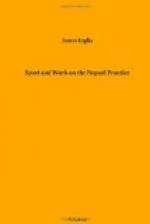Round two sides of the field, they have previously put fine nets, and at the apex they have a large cage with a decoy quail inside, or perhaps a pair. The quail is a running bird, disinclined for flight except at night; in the day-time they prefer running to using their wings. The idiotic looking old cow, as we will call the hunter, has all his wits about him. He proceeds very slowly and warily, his keen eye detects the coveys of quail, which way they are running; his ruse generally succeeds wonderfully. He is no more like a cow, than that respectable animal is like a cucumber; but he paws, and tosses, and moves about, pretends to eat, to nibble here, and switch his tail there, and so manoeuvres as to keep the running quail away from the unprotected edges of the field. When they get to the verge protected by the net, they begin to take alarm; they are probably not very certain about the peculiar looking ‘old cow’ behind them, and running along the net, they see the decoy quails evidently feeding in great security and freedom. The V shaped mouth of the large basket cage looks invitingly open. The puzzling nets are barring the way, and the ‘old cow’ is gradually closing up behind. As the hunter moves along, I should have told you, he rubs two pieces of dry hard sticks gently up and down his thigh with one hand, producing a peculiar crepitation, a crackling sound, not sufficient to startle the birds into flight, but alarming them enough to make them get out of the way of the ‘old cow.’ One bolder than the others, possibly the most timid of the covey, irritated by the queer crackling sound, now enters the basket, the others follow like a flock of sheep; and once in, the puzzling shape of the entrance prevents their exit. Not unfrequently the hunter bags twenty or even thirty brace of quail in one field, by this ridiculous looking but ingenious method.
The small quail net is also sometimes used for the capture of hares. The natives stretch the net in the jungle, much as they do the large nets for deer described in a former chapter; forming a line, they then beat up the hares, of which there are no stint. My friend Pat once made a novel haul. His lobarkhanna or blacksmith’s shop was close to a patch of jungle, and Pat often noticed numbers of quail running through the loose chinks and crevices of the walls, in the morning when anyone went into the place for the first time; this was at a factory called Rajpore. Pat came to the conclusion, that as the blacksmith’s fires smouldered some time after work was discontinued at night, and as the atmosphere of the hut was warmer and more genial than the cold, foggy, outside air, for it was in the cold season, the quail probably took up their quarters in the hut for the night, on account of the warmth and shelter. One night therefore he got some of his servants, and with great caution and as much silence as possible, they let down a quantity of nets all round the lobarkhanna, and in the morning they captured about twenty quails.




